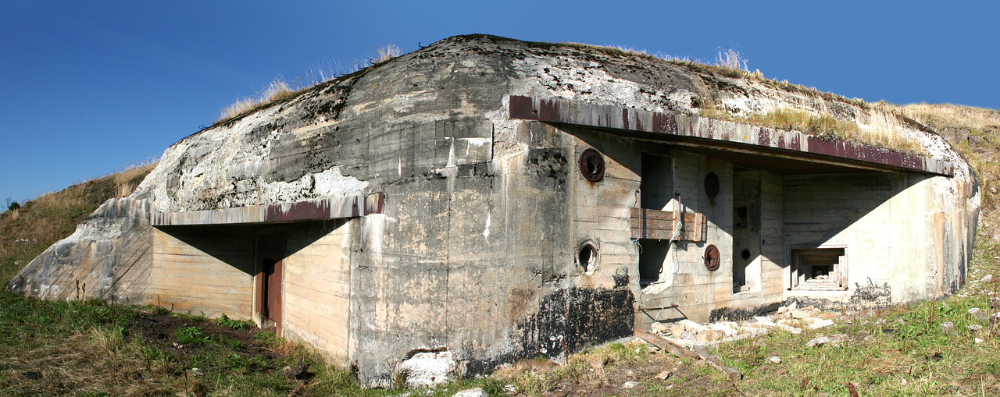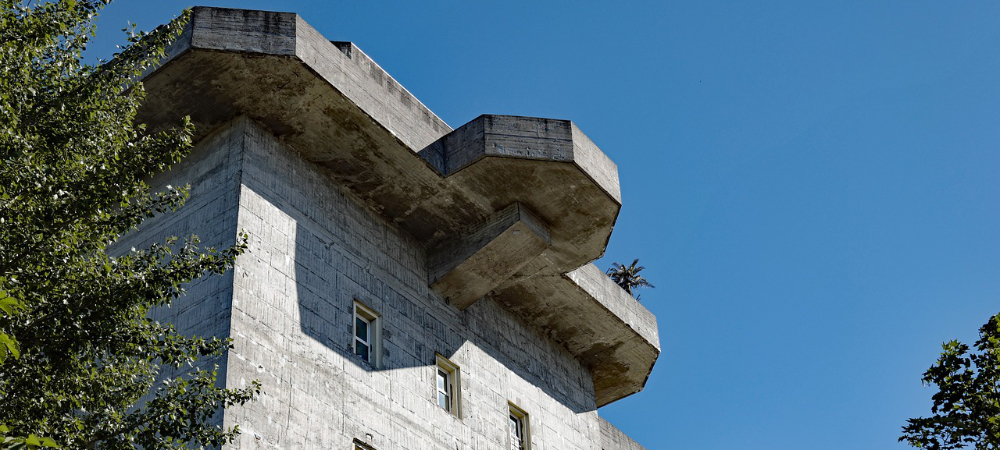Bunker
Bunker is usually a term used to describe a protective, reinforced or fortified building, often underground but also free standing. Such storm, military, wartime, nuclear bunkers or safe houses were often made of thick, strong, reinforced bomb blast resilient concrete, but the term could also be used to describe dug out areas of land or trenches to protect from enemy attack. The term sangar may also be used to describe such a pit or specifically rifle pit for a soldier, often built up at the edges with loose stones.
According to Subterranea Britannica there are some 275 bunkers located in the UK, many are disused, some remain useable and some have been adapted for reuse or incorporated into developments. There are also any bunkers located across Europe, with a similar story, some being converted into art galleries, others into hotels as well as homes.
Bunker can also refer to a buildings or spaces used for storage, in particular fuel. Again built with protective walls to prevent explosion or ignition of the fuel or ammunition. The fuel used in shipping may still be referred to as bunker fuel, which dates back to when the fuel used was coal and it was stored in a bunker on board the ship.
Bunker might also be used to describe an external storage area, often partly underground, which remains a constant lower temperature and is used to store food, also referred to as an earth cellar (or root cellar in the US) with a similar function to a larder, buttery or pantry.
[edit] Related articles on Designing Buildings
- Admixtures in concrete.
- Angstloch.
- Basement excavation.
- Basement Excavation (Restriction of Permitted Development) Bill.
- Basement impact assessment.
- Basement v cellar.
- Basement waterproofing.
- Basements.
- Bund.
- Cast-in-place concrete.
- Cellular concrete.
- Concrete.
- Concrete frame.
- Concrete-steel composite structures.
- Design of durable concrete structures.
- Earth bermed buildings.
- Excavation.
- Ferro-cement.
- Fly ash.
- Formwork.
- Gabion.
- Global undergrounds - exploring cities within.
- Glass reinforced concrete.
- Graphene-reinforced concrete.
- Grouting in civil engineering.
- Isokon Flats.
- Maunsell forts.
- Oubliette.
- Pantry, buttery, larder and scullery.
- Planning (Subterranean Development) Bill.
- Prestressed concrete.
- Recycled concrete aggregate RCA.
- Reinforced concrete.
- Safe houses.
- Substructure.
- Stad Ship Tunnel.
- The Lowline.
- The properties of concrete.
- Tired of the commute? It might be time to take cars underground.
- Tunnels.
- Underground.
Featured articles and news
The UK's Modern Industrial Strategy: A 10 year plan
Previous consultation criticism, current key elements and general support with some persisting reservations.
Building Safety Regulator reforms
New roles, new staff and a new fast track service pave the way for a single construction regulator.
Architectural Technologist CPDs and Communications
CIAT CPD… and how you can do it!
Cooling centres and cool spaces
Managing extreme heat in cities by directing the public to places for heat stress relief and water sources.
Winter gardens: A brief history and warm variations
Extending the season with glass in different forms and terms.
Restoring Great Yarmouth's Winter Gardens
Transforming one of the least sustainable constructions imaginable.
Construction Skills Mission Board launch sector drive
Newly formed government and industry collaboration set strategy for recruiting an additional 100,000 construction workers a year.
New Architects Code comes into effect in September 2025
ARB Architects Code of Conduct and Practice available with ongoing consultation regarding guidance.
Welsh Skills Body (Medr) launches ambitious plan
The new skills body brings together funding and regulation of tertiary education and research for the devolved nation.
Paul Gandy FCIOB announced as next CIOB President
Former Tilbury Douglas CEO takes helm.
UK Infrastructure: A 10 Year Strategy. In brief with reactions
With the National Infrastructure and Service Transformation Authority (NISTA).
Ebenezer Howard: inventor of the garden city. Book review.
The Grenfell Tower fire, eight years on
A time to pause and reflect as Dubai tower block fire reported just before anniversary.
Airtightness Topic Guide BSRIA TG 27/2025
Explaining the basics of airtightness, what it is, why it's important, when it's required and how it's carried out.
Construction contract awards hit lowest point of 2025
Plummeting for second consecutive month, intensifying concerns for housing and infrastructure goals.
Understanding Mental Health in the Built Environment 2025
Examining the state of mental health in construction, shedding light on levels of stress, anxiety and depression.
























